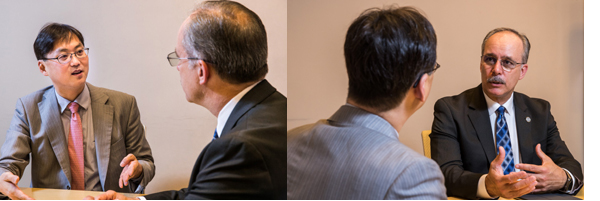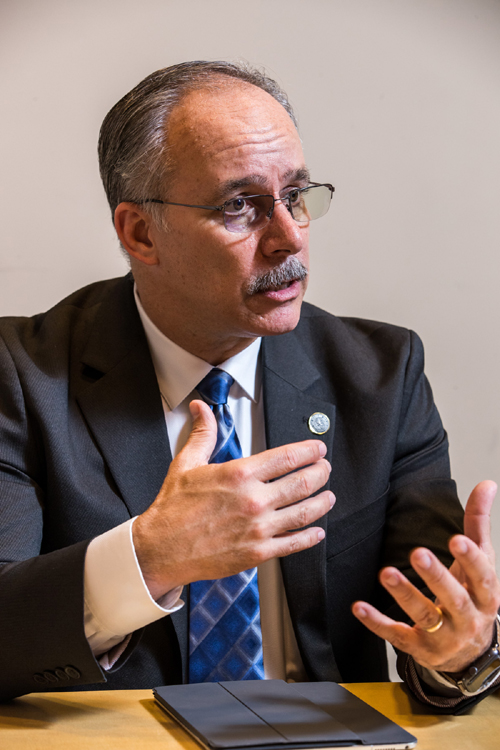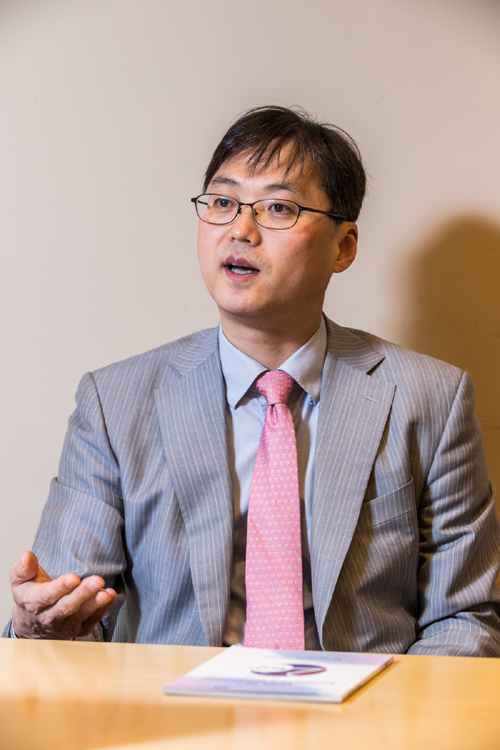Lee, Tucker talk about new trends in e-Consent, virtual clinical research
Celebrating the 20th anniversary this year, the Korea Cancer Study Group (KCSG) is paying attention to electronic informed consent (e-Consent) and virtual clinical trials to help Korean patients gain easier access to new anticancer treatments.
The association is particularly keen on addressing misunderstandings and worries about clinical trials.
Anticancer clinical trials offer treatment opportunities with higher risks of side effects. Due to such risks, participating patients must understand information about the study accurately, experts say.
The KCSG recently invited Michael Tucker, senior product solutions specialist at Medidata, to its 20th-anniversary symposium to share knowledge about e-Consent, a new trend in clinical trials, and virtual clinical research. Medidata is a global provider of cloud-based solutions and data analytics for clinical research.
Korea Biomedical Review met Lee Dae-ho, a professor of oncology at Asan Medical Center, and Tucker to share their insights on the latest trends in e-Consent and virtual clinical research. Lee also serves as a member of the KCSG’s planning committee.

KBR: What is the difference between clinical trials 20 years ago and current ones?
Lee: It was in the early 2000s that clinical trials began to be appropriately carried out in Korea. Patients have more treatment opportunities now than in the early 2000s. Clinical trial procedures and criteria have become stricter, too. This is because Korea has followed international standards. The country is a member of the International Council for Harmonization of Technical Requirements for Pharmaceuticals for Human Use (ICH). Also, Korea is abiding by the Good Clinical Practice (GCP).
KBR: Virtual clinical trials are designed to allow patients to use smart devices to transmit their physical changes to reduce the number of hospital visits. However, don’t they have reproducibility issues?
Lee: A virtual clinical trial’s reproducibility can vary depending on the characteristics of research. It can also differ depending on the clinical stage, medicines, and diseases. Dosage regimen has become easier and drugs with a long duration up to three months are available now. Clinical trial participants usually visit the hospital every four weeks. On a virtual study, patients can send adverse drug effects and side effects via electronic data. If the study is in phase-4, the virtual research can reduce the number of hospital visits.
Also, virtual clinical trials allow more patients to participate. One of the reasons that patients cannot join clinical research is a long distance between their home and the hospital. Howsever, virtual clinical trials provide a joint system, allowing regional clinical trial centers to carry out more studies.

Tucker: In virtual clinical research, data from automated devices such as smart devices, blood glucose meters, and scales can be automatically transferred. The quality of the data value becomes better in this process.
KBR: We heard that many local experts were interested in Tucker’s lecture on e-Consent.
Lee: E-Consent forms are expanding in many other countries. In the future, e-Consent will become a standard in clinical trials because patients find it much easier to see it in pictures and animations than to read the long-written form. The longer the consent form, the more they misunderstand about the trial. Some even refuse to participate. E-Consent allows explanations in pictures and animations. It can be well organized. However, there is a security issue.
Tucker: Medidata has been providing e-Consent service for about a year. E-Consent not only gets patient consent but includes education. Patients can add questions themselves, check if they learned about important information accurately, and receive a reinforced form if they felt dissatisfied. E-Consent offers an adequate explanation of the necessary part only.
KBR: How do you provide e-Consent for a patient?
Tucker: When we start a study, we show them animations to let them know what the study is about. Then, the patient reads on about the content of the study and side effect risks. If the patient comes up with an unknown word, he or she can click on it to see an additional explanation.
After reading the content, the electronic form pops quizzes to see if the patient understood it. If the patient gets wrong, the form gives a hint and goes back to the related content. If the patient is wrong again on the same problem, the arrangement offers information about it.
We provide e-Consent to allow the patient or the guardian to check the content at any time. It can also check who accessed it when and where preventing forgery.
KBR: Are there clinical trials providing e-Content in Korea too?
Lee: Asan Medical Center is participating in Roche’s global clinical trials. As Roche is using e-Consent, the hospital plans to use it, too.
We have finished preparation, but we have to decide what to do with the patient signing. If related regulations are made, and e-Consent becomes commercialized, there will be significant changes in patient-centered clinical trials.
KBR: Do you think e-Consent will raise participation in clinical trials?

Lee: Of course, I do. Physicians can believe that they have sufficiently explained the purpose of the clinical trial and its risks one on one. Howefer, it may difficult for patients to understand them. Patients can even forget what they have heard. E-Consent gives sufficient information in advance so that patients can understand it accurately.
Tucker: A study at a California-based hospital randomly gave half of the patients the paper consent and the other half, the e-Consent. After 24 hours, the online survey on the patients showed that those who wrote e-Consent remembered 75 percent of the content, while those with the paper form recognized only 58 percent. The use of the technology can help patients gain better understanding, information, and knowledge.
Now, 19 countries have adopted the e-Consent system. Among them, nine introduced Medidata’s system. As the program helps patients participate in more clinical studies, we can try out new treatments.
KBR: Professor Lee, as you’re one of the Korean experts in this area, you seem to have confidence in the success of e-Consent.
Lee: Yes, I do. Although only the large hospitals like ours begin to use e-Consent, more hospitals will use it gradually. There will be more clinical study sites and more convenience for patients. Patients will be able to participate in studies more actively.
However, e-Consent is like a two-edged sword. We’re in the right direction to promote the use of e-Consent, but we should think about how the local system should introduce it, how fast, and how safely. E-Consent is applied only to clinical trials now, but I hope that it can be used for general medical examinations. Then, we will be able to resolve many problems coming from the information gap between patients and doctors.

